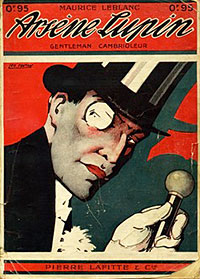 One of the most popular characters in French literature is Arsène Lupin. He holds a position similar to that of Sherlock Holmes, which is interesting as they came out around the same time, and Lupin even went up against Holmes in a few of his earlier adventures — though to avoid issues with Conan Doyle, the character was re-named “Herlock Sholmes.” Because it’s no longer necessary to do so, I’ve restored the name for this posting.
One of the most popular characters in French literature is Arsène Lupin. He holds a position similar to that of Sherlock Holmes, which is interesting as they came out around the same time, and Lupin even went up against Holmes in a few of his earlier adventures — though to avoid issues with Conan Doyle, the character was re-named “Herlock Sholmes.” Because it’s no longer necessary to do so, I’ve restored the name for this posting.
So who is Arsène Lupin?
Lupin is the literary descendant of characters like Rocambole. He starts out as a “gentleman-thief,” though he prays on people much worse than he is, and does it with style and panache. Over time he becomes more of an independent detective and adventurer, solving mysteries and helping others. One could think of him as similar to Simon Templar, the Saint.
He was created by Maurice Leblanc, who set things up in the series such that he casts himself as Lupin’s “biographer” and even hints at unwritten adventures, similar to Holmes’ stories.
There are 20 official volumes (novels and short story collections), and five official sequels by others. Sadly, most of the series is not readily available in English. Some are available from Black Coat Press with more coming, whereas others are available from Wildside Press.
The original series includes:
- “Arsène Lupin, Gentleman Burglar” (1907, collection of nine stories)
- “Arsène Lupin vs. Sherlock Holmes” (1908, collection of two stories) (aka “The Blonde Lady”)
- “The Hollow Needle” (1909)
- “813” (1910)
- “The Crystal Stopper” (1912)
- “The Confessions of Arsène Lupin” (1913, collection of nine stories)
- “The Shell Shard” (1916) [Not originally part of the Arsène Lupin series, Lupin written into the story in later editions.]
- “The Golden Triangle” (1918) (aka “The Return of Arsène Lupin”)
- “The Island of Thirty Coffins “(1919) (aka “The Secret of Sarek”)
- “The Teeth of The Tiger” (1921)
- “The Eight Strokes of The Clock” (1923 collection 8 stories)
- “The Countess of Cagliostro” (1924) (aka “Memoirs of Arsène Lupin”)
- “The Damsel With Green Eyes” (1927)
- “The Barnett & Co. Agency” (1928) (aka “Arsène Lupin Intervenes”)
- “The Mysterious Mansion” (1929) (aka “The Melamare Mystery”)
- “The Mystery of The Green Ruby” (1931)
- “The Woman With Two Smiles” (1933) (aka “The Double Smile”)
- “Victor of the Vice Squad” (1933) (aka “The Return of Arsène Lupin”)
- “The Revenge of The Countess of Cagliostro” (1935)
- “The Billions of Arsène Lupin” (1939)
- “The Last Love of Arsène Lupin” (unpublished)
I had picked up a book from Penguin titled “Arsène Lupin: Gentleman-Thief,” thinking it the first volume. It’s not, being more a “best of” collection taken from three collections: “Gentleman-Burglar,” “Confessions,” and “Eight Strokes of the Clock.” It is a good introduction to the character, but don’t make the mistake I did.
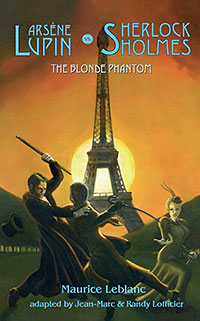 Black Coat Press has so far put out four volumes of Lupin stories: “Arsène Lupin vs. Sherlock Holmes: The Hollow Needle,” “Arsène Lupin vs. Sherlock Homes: The Blond Phantom,” “Arsène Lupin vs. Countess Cagliostro,” and “The Many Faces of Arsène Lupin.” Two more are coming: “The Island of the Thirty Coffins” and “813.” These are all new translations.
Black Coat Press has so far put out four volumes of Lupin stories: “Arsène Lupin vs. Sherlock Holmes: The Hollow Needle,” “Arsène Lupin vs. Sherlock Homes: The Blond Phantom,” “Arsène Lupin vs. Countess Cagliostro,” and “The Many Faces of Arsène Lupin.” Two more are coming: “The Island of the Thirty Coffins” and “813.” These are all new translations.
“The Hollow Needle” contains the first written encounter between Lupin and Holmes, “Sherlock Holmes Arrives Too Late” that appeared in the first collection, along with the third book and additional materials by Jean-Marc and Randy Lofficier of Black Coat Press.
The story is built around a real natural rock formation off the Normandy Coast near Etretat known as “The Needle.” Leblanc postulates that it is hollow and housed the secret treasures of the Kings of France, which both Lupin and Holmes are after. Apparently to this day some people believe the formation is hollow! Interestingly, Holmes is not the main antagonist in the story. That role is taken by young detective Isidore Beautrelet, who is clearly a homage to Gaston Leroux‘s reporter/detective character Rouletabille, another classic French character.
“The Blond Phantom” contains the works from the second Lupin volume along with additional materials by the Lofficiers. In these stories, Lupin and Holmes go back and forth trying to outwit each other.
“Arsène Lupin vs Countess Cagliostro” collects together all the battles between Lupin and Josephine Balsalmo, the Countess Cagliostro. People may not be aware that Joseph Balsamo, the so-called Count Cagliostro, was a real person, who was involved with Queen Antionette‘s necklace (the so-called “affair of the necklace”). Since then he has been used in fiction, starting with Alexander Dumas’s “Joseph Balsamo.” This volume has the short story, “The Queen’s Necklace,” from the first collection, and the contents of “The Countess Cagliostro” and “the Revenge of Countess Cagliostro,” as well as additional materials by the Lofficiers. Because of the popularity of this story, Countess Cagliostro has been cast by some as Lupin’s main opponent — his Moriarty, if you will. Rick Lai has used the Countess in his recent collection of stories.
“The Many Faces of Arsène Lupin” is a collections of short stories. There are two never-before-translated stories by Leblanc, along with 19 new stories by others, five of which are new to this collection. Those stories either appeared in the first six volumes of the “Tales of the Shadowmen” or the previous Black Coat Press Lupin volumes. These are arranged in internal chronological order.
A concept put forth by Leblanc is the idea of four great secrets of Queen Antionette and Count Cagliostro, which were revealed to a young Lupin by the Countess. The first of these was solved in “The Hollow Needle.” The next is another treasure revealed in “The Countess Cagliostro.” The third is the “god-stone of Sarek,” which is the center of the plot of the upcoming “The Island of the Thirty Coffins.” The fourth secret was actually not solved by Lupin, but by another Leblanc character, the heroine Dorothy, in “Dorothy the Rope Dancer” (aka “The Secret Tomb”).
The next planned Arsène Lupin book from Black Coat is “813.” This is great news as it’s said to be the greatest Lupin adventure. Further, this will be the first complete English translation, as the standard one leaves out a chapter and a half from the original. Lupin is trying to solve the mystery of “813” (which stumped Holmes, who is mentioned but does not appear), which will have repercussions on Europe. But Lupin’s real adversary is the mysterious, unnamed character: a black-clad, nearly superhuman killer known only as L.M. This volume will also have a new story that explains why Holmes wasn’t in the novel.
Another publisher that has put out Lupin works is Wildside Press. Some of the volumes they have done include “Arsen Lupin,” “The Blonde Lady,” “The Hollow Needle,” “813,” “The Crystal Stopper,” “Confessions,” “Golden Triangle,” “The Secret of Sarek,” “Teeth of the Tiger,” and “Eight Strokes of the Clock.” I’m not sure I can recommend them, as I’m uncertain of the source of the materials. If they are using the English translations by Alex Texeira, these are not very good and left material out. I’d rather get the ones from Black Coat Press.
As a popular character, Lupin has appeared in other formats, including TV, radio, movies, comics, and plays. There is a page at Black Coat Press that lists many of these. You can also see clips from the TV shows and movies on YouTube, but as far as I know, they have not been translated into English. A recent new movie is a fairly faithful adaptation of “Countess Cagliostro.”
An interesting spin-off, for lack of a better term, is Lupin III, the grandson of Arsène Lupin who is the star of Japanese manga and anime. One of the best Lupin III anime is “Castle of Cagliostro” by the well-regarded animation director Hayao Miyazaki.
There have been other “gentleman-thief” characters who have come before, such as AJ Raffles, or followed, like Simon Templar. But Arsène Lupin is in many ways a trendsetter of this genre. Check him out.


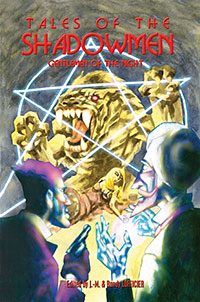


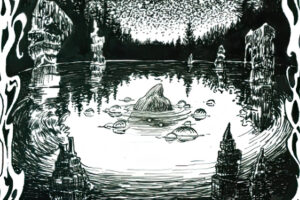
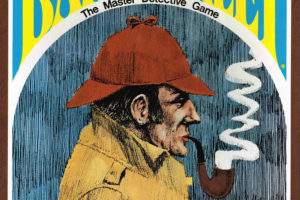
Erle Stanley Gardner’s Lester Leith was a pulp character who followed in Monsieur Lupin’s footsteps.